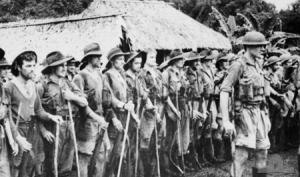![]() The Pacific War Online Encyclopedia
The Pacific War Online Encyclopedia
|
| Previous: Military Police | Table of Contents | Next: Millikin, John |

Australian War Memorial #013289
A militia is a body of civilians with military
training who may be called to
service in time of emergency.
Historically, militias have been seen as a more politically palatable
alternative to large standing armies. They have often been called out
in response to non-military emergencies such as natural disasters.
Militia are distinct from reservists, who are
usually discharged regular soldiers who are subject to recall in time
of war. The distinction between the two can become blurred.
United States. The organized militia of the United States is the National Guard, whose officers and men are recruited by individual states but trained and equipped under the direction of the federal government. Because the United States never suffered a large-scale invasion, National Guard divisions were shipped overseas after being called to the colors. All received additional training before being committed to combat, and many performed well. Others showed the effects of lackluster leadership, inadequate training, and the somewhat older average age of their men.
In addition to the organized militia, the entire
body of male citizens are considered part of the unorganized militia of
the United States. Because of the rural frontier heritage of many
Americans, sometimes characterized as a "gun culture," a significant
percentage of men who had never previously served in the Army or the
National Guard nevertheless came to the Army with some familiarity with
small arms.
Australia. The Australian militia was
known formally as the Citizen's
Military Forces. They included
conscripts and were distinct
from the all-volunteer Australian Imperial
Forces. In particular, by law, the CMF could not be deployed
outside
Australia. As the war progressed and manpower became shorter, the law
was changed to allow the CMF to operate in New Guinea and the Solomons,
then throughout Southeast Asia. Looked down on with contempt by AIF
volunteers, the CMF nonetheless fought well in some of its engagements,
particularly on the Kokoda Trail
and at Milne Bay.
Canada. Historically, all Canadian land forces were referred to as militia, even though they were professional soldiers. Later this term came to refer to the reserve.
Netherlands. Most of the Dutch troops that fought against the Japanese Centrifugal Offensive were not professional soldiers, but it is unclear whether they should be regarded as militia or as reservists. In training and capability they more strongly resembled the former.
Japan. The concept of a citizen militia was foreign to the Japanese, for
whom
military training and the possession of arms were historically the
exclusive right of the samurai.
However, samurai were
encouraged to settle their families in Hokkaido
following the conclusion the Boshin Civil War in 1869, to serve as a
ready militia
against any Russian incursion from Sakhalin. The Japanese Army later
adopted the concept of reservists, along with
other features of European armies, and the Kwantung
Army encouraged reservists to settle in Manchuria, again as a ready militia
against the Russian threat.
Later, as Japan
itself was threatened with invasion, militia were organized in the home
islands. These militia were largely untrained and very poorly armed,
sometimes with nothing more than bamboo spears, and they were expected
to use suicide tactics to make
up for their weakness. It has been estimated that the militia in Japan
numbered 28 million by the time of the surrender.
References
National Guard Virtual Armory (accessed 8 January 2007)
The Pacific War Online Encyclopedia © 2007-2009, 2012 by Kent G. Budge. Index